The following article was first published in the March 2013 issue of Apollo.
The first English visitor to Moscow arrived by accident. In May 1553, Richard Chancellor had set sail as captain of the Edward Bonaventure, one of three ships dispatched by the Company of Merchant Adventurers to locate a passage to Cathay through the north-eastern seas. By August, the three vessels had been scattered in a storm – two entire crews, including that of expedition commander Sir Hugh Willoughby, would freeze to death in a remote northern estuary on the Kola Peninsula that winter – but Chancellor voyaged on, reaching the White Sea port of St Nicholas by the end of the month. From there he was conducted south on a journey of more than 600 miles by sled, over ice and snow, to the court of Ivan IV (‘the Terrible’) at Moscow.
The Englishman’s fluke appearance before the Tsar swiftly disclosed commercial and political opportunities. Chancellor was well received by Ivan, the ambitious ruler of a recently centralised state, who saw exchange or alliance with the English as a prospective means of bolstering both his actual military potential and his symbolic footing on the European stage. He promised trading privileges to the English and in 1555, shortly after Chancellor’s return to London, the Muscovy Company was officially incorporated by royal charter. On his second visit to Moscow in 1556, Chancellor came in the guise not of an explorer but of an ambassador.
The following century saw much profitable understanding – and not a little misunderstanding – between the English and Russian courts, as the Muscovy Company sought with varying success to safeguard and extend its commercial options in the region. For the tsars, meanwhile, the opportunity to monitor foreign trade became a way of managing both their own domestic authority and Russia’s international presence (to his enemies at least, Ivan IV became known as ‘the English Tsar’) . The English traded textiles, metalwork and munitions in Russia, as well as importing the type of craftsmanship and expertise that would lead to such commissions as St Saviour’s Tower in the Kremlin, redesigned by the Scottish clockmaker Christopher Galloway in the early 17th century. They exported furs, tallow, hemp, and – as a burgeoning maritime power – cordage for rigging and large timber for masts.
But the English also brought a series of lavish gifts for successive tsars, from jewels and fine cloths to birds and animals. In 1604, Sir Thomas Smith presented Tsar Boris Godunov with a vast, highly decorated ‘chariot’ or coach, an outlandish contraption whose arrival so far from its place of manufacture at a time when the European fashion for carriages was in its infancy must have seemed like a feat of necromancy. These gifts were intended to fulfil a range of political purposes: advertising the wealth of the English court and the skill of its craftsmen, fawning over the Tsar, and mollifying Russian objections to what seemed, at times, a crude intersection between courtly and commercial pursuits.
Some of these objects, and the complex diplomatic history in which they played a part, are the intriguing focus of ‘Treasures of the Royal Courts: Tudors, Stuarts and the Russian Tsars’ (9 March–14 July 2013) at the Victoria and Albert Museum in London, the latest in a series of collaborative exhibitions between the V&A and the Moscow Kremlin Museums. (Previous collaborations include ‘Diaghilev and the Golden Age of the Ballets Russes, 1909–1929’ in London, winter 2010–11, and ‘The Golden Age of the English Court: From Henry VIII to Charles I’, which opened in Moscow in October 2012.) Alongside a lively range of items – including armour, portrait miniatures, jewellery and textiles – from the V&A and other British collections, the exhibition boasts a number of impressive loans from institutions in the Russian capital. Among them are a 17th-century equestrian portrait of Tsar Mikhail Romanov from the State Historical Museums and, most significantly, a selection of the outstanding early modern English silver housed in the Kremlin Armoury Museum. Godunov’s chariot, also in the museum but too fragile to travel, will be represented at the V&A by a specially commissioned film.
The Kremlin Armoury Museum, with its collections centred on the contents of the tsars’ treasury, holds around 500 pieces of English silver. Of these, more than 100 were manufactured between the late Tudor period and the mid 17th century; many were presented as ambassadorial gifts, while some were acquired by the Tsar from representatives of the Muscovy Company. It is a collection with few rivals: given their substantial material worth, it is doubtful that the pre-Commonwealth pieces would have survived the political upheaval – and fervent silver-melting – of the mid 17th century had they remained in England. Silver has always retained its value as a precious metal quite apart from whatever prestige it accrues when worked into decorative or ceremonial objects; the association between silver and various types of institution, from the livery company to the church to the head of state, inevitably means that its survival is jeopardised whenever they come under threat. It is an eminently recyclable material: consider Louis XIV’s decision to melt the silver furniture at Versailles in 1689 to fund his military exploits. Indeed, one of the V&A’s own exceptional pieces of early English silver, Christian van Vianen’s Dolphin Basin of 1635, testifies to the vulnerability of plate in the period. With its matching ewer lost, the basin’s illusionistic aquatic decoration does more than boast of how silver can represent a liquid: it also seems to acknowledge how easily it might revert to one.
It is appropriate that a selection of the Kremlin‘s early English silver should be displayed at the V&A, the repository of the National Collection of English Silver. It will be exhibited alongside some of the London museum’s most important pieces, including the Dolphin Basin and the Mostyn salt (1563–64); silver specialists will no doubt relish the opportunity to compare objects from the two collections. Even so, silver plate is among the most difficult of the applied arts to set before today’s museum-going public. Its functional and decorative aspects can seem dishearteningly elitist and remote, and the techniques involved in its manufacture are formidably complex. It is to the credit of curator Tessa Murdoch, along with colleagues from the Moscow Kremlin Museums, that this exhibition seeks to establish a narrative for these objects, encouraging visitors to consider how their status and function as ambassadorial gifts might illuminate their formal and stylistic characteristics.
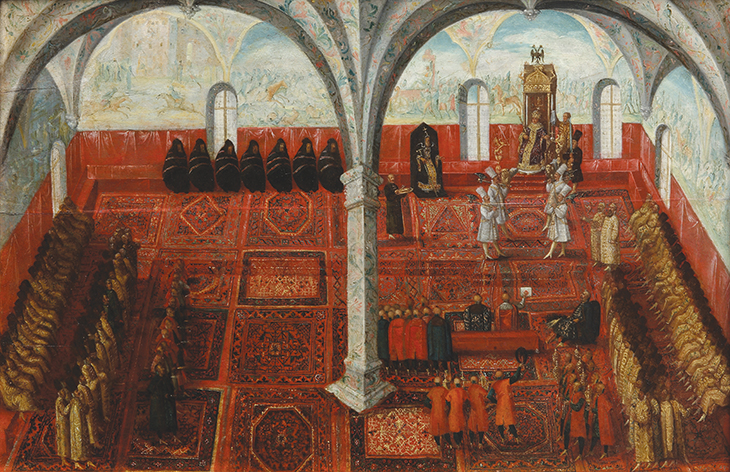
A Tsar Receiving a Delegation in the Hall of the Palace of Facets (1630s), attr. to Simon Boguszowick. Hungarian National Museum, Budapest
Sixteenth-century diplomatic missions were no place for last-minute presents. The bestowal of ambassadorial gifts played an important role in the reception of foreigners at the Russian court, part of its carefully codified and highly theatrical demonstration of power (as William Morris wrote: ‘Hamlet […] should have been a Russian not a Dane’) . The emphasis of successive English missions on silver gifts was in part motivated by what their predecessors in Russia had witnessed at the Kremlin: official audiences with the Tsar often took place in the Palace of the Facets, where, in the lofty Italianate surroundings, a great arrangement of plate was laid out as a sumptuous boast of the Treasury’s existing possessions. The great Soviet Russian filmmaker Sergei Eisenstein later caught something of this exaggeration of luxury in the first part of his Ivan the Terrible (1944), dwarfing his film Tsar beside vast ewers and swan-shaped table objects.
Clement Adam, who chronicled Richard Chancellor’s travels in Muscovy, described how: ‘In the middes of the roome, stoode a mightie Cupboorde […] Upon this Cupboorde was placed the Emperours plate, which was so much, that the very Cupboord it selfe was scant able to sustayne the weight of it: the better part of all the vessels, and goblets, was made of very fine golde.’ Adam’s astonishment at the weight of the objects presumably registers his recognition of the actual value of so much precious metal. The author of the report on Sir Thomas Smith’s mission (1604–05) was more interested in its decorative variety, recording ‘wonderfull great peeces of plate, very curiously wroght with all manner of Beastes, Fishes and fowles’.
The English silver imported into Russia was carefully selected, then, to gratify a taste that set great store by both abundant and elaborate metalwork. It was often chosen from the royal Jewel House at the Tower of London. The sheer exuberance of forms and decorative styles in the Kremlin collection suggests that these items were meant to flaunt the ingenuity of English silversmiths; they include unusual flasks or ‘pilgrim bottles’, livery pots, and a variety of cups and dishes often decorated in the latest fashion. They were presented in a pre-orchestrated order, opening with the blockbuster items. Smith’s embassy brought ‘a charyott, two great flaggons, a christall cuppe, a bason and ewer, two haunche pottes, one standing cuppe, one peece of Scarlett and fowre peeces of other fine cloathe’.
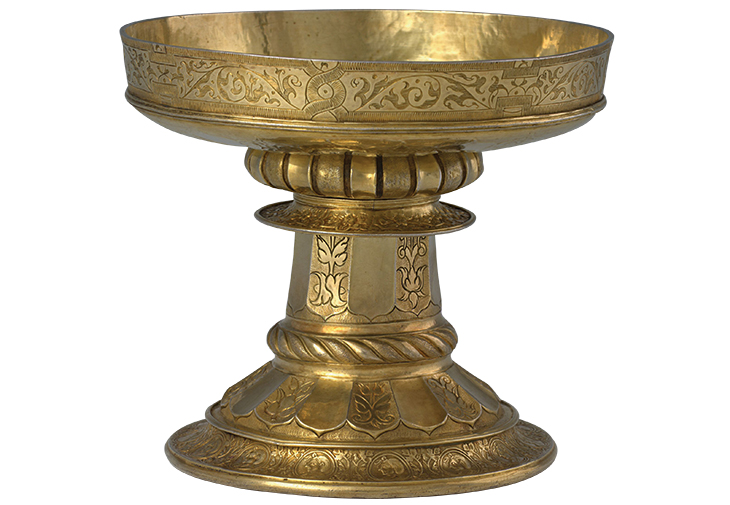
Font-shaped cup (1557–58), English (London). The Moscow Kremlin Museums
The earliest piece of English silver in the Kremlin Armoury Museum is a font-shaped cup dating to 1557–58. It is sober in comparison to the gifts that would follow, a stout little object with bold horizontal articulation that lends it a grounded appearance – an appropriately sturdy form, perhaps, for an ambassador to present on a visit designed to stabilise a fledgling alliance. It may have been brought to the Kremlin by Sir Anthony Jenkinson, who led four missions to Russia between 1557 and 1571, securing trading rights in the recently annexed territories of Kazan and Astrakhan. Jenkinson’s corrected map of Muscovy and Tartary was among the earliest intellectual returns of the Anglo-Russian relationship.
It is perhaps due to their status as ambassadorial gifts – as things carried between two countries in order to forge some kind of congruence between them – that the interplay between national and European styles should seem so fascinating in the early English silver held in the Kremlin. Some of these pieces have forms that are distinctively English: thistle cups, for instance, with their unusual diamond faceting, giving a prickly heraldic makeover to the ovoid bowl shape often preferred in standing cups. Another notably English type is the conical flagon with a long, stretched neck, known as ‘a pilgrim bottle’ because of its resemblance to those flasks carried by travellers to the Holy Land; often created in pairs, these were particularly apt gifts.
Other silver items transported unmistakably English decorative sensibilities to the Russian court. Cups or water pots were engraved or chased with floral motifs that glinted with emblematic significance – some featured the Tudor dog rose, symbol of Elizabeth I herself, or the daisies of Lady Margaret Beaufort, mother of the first Tudor king, Henry VII. The English preference for nautical decoration – shells, dolphins, tritons and any manner of sea monster – must have had a strange resonance in Moscow, brought by these sea travellers making voyages deep inland.

Gourd-shaped cup (1604–05), English (London). The Moscow Kremlin Museums
Other silver objects in the Kremlin collection demonstrate the English adaptation of continental styles. Its gourdshaped cups, for instance, magnificent bulbous vessels with stems crafted like tree trunks, are modified forms of German cups in which the stems look more like saplings than these gnarled English variants. The cylindrical livery pots or Hansekanne, which featured frequently among English ambassadorial gifts, were so called because of their popularity as drinking vessels in those Baltic towns allied together as part of the Hanseatic League. And ornamental motifs were as liable to be translated between national schools as forms were; the movement of craftsmen and the increasing dissemination of printed material meant that patterns could slip across borders without being fixed on to objects. Detailed, engraved grotesques were popularised by the Flemish engraver Niçaise Roussel, who moved to London from Bruges in the 1570s and published his designs in 1623. Later in the 17th century, the Dutch Blumenmode, or fashion for flowers, was fast taken up by English silversmiths; departing from established Renaissance decorative precepts, which saw the orderly division of the surface into distinct areas, they adopted a type of continuous decoration that wrapped the silver with flowers and foliage in high relief chasing. The addition of miniature hounds, hinds and horses was a whimsical English touch.
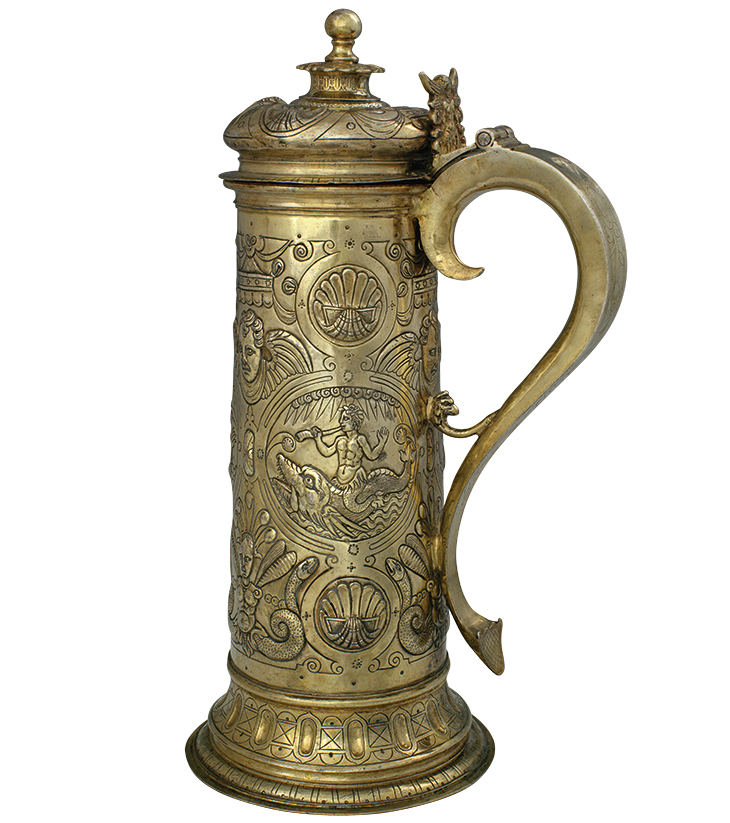
Livery pot (1613–14), probably William Rayne the Elder. The Moscow Kremlin Museums
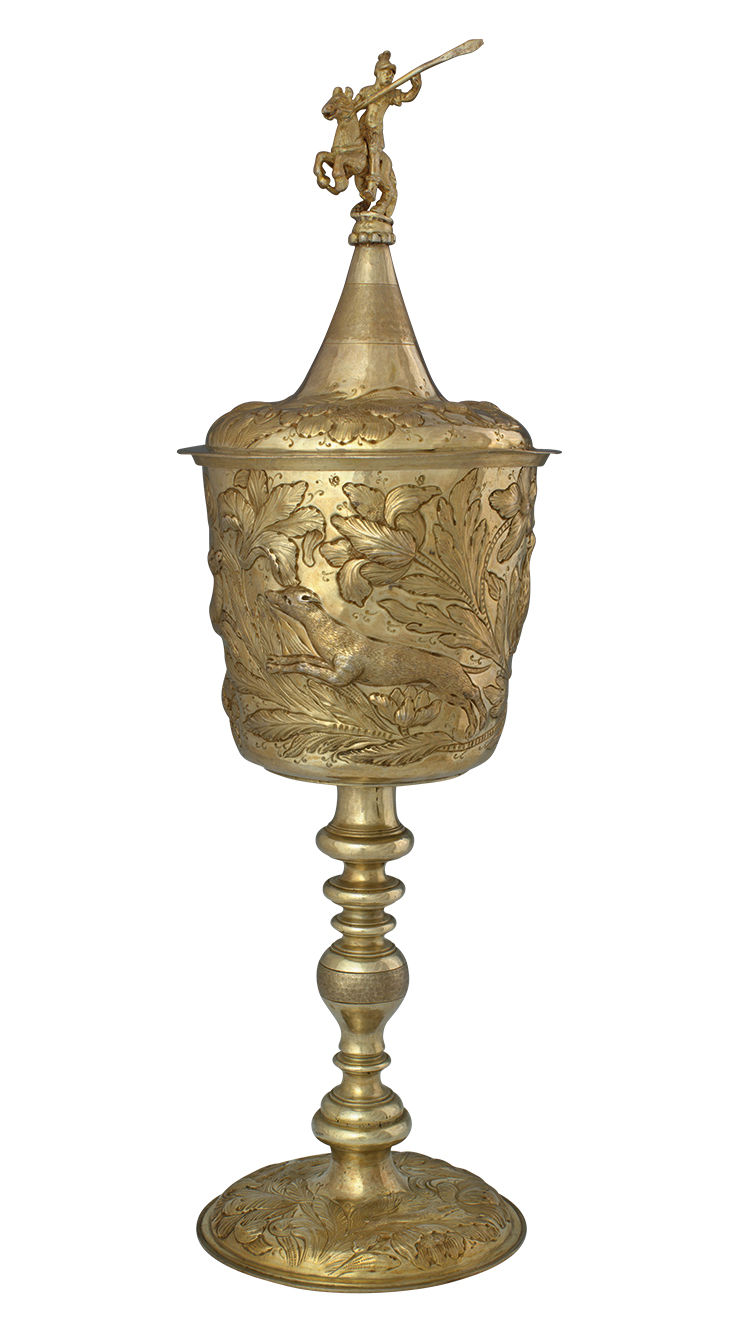
Standing cup (c. 1663), Francis Leake. The Moscow Kremlin Museums
But these objects register political and diplomatic strain as well as accord and exchange, in both international and domestic contexts. A massive basin and ewer with martial subjects, made not in England but France, were presented to the Tsar in 1664 by Charles Howard, 1st Earl of Carlisle; they had been part of the dowry of Charles II’s mother, Henrietta Maria, and must have had extra significance as part of a mission aimed at resuming trade links severed by Russia following the execution of his father. Some of the most extraordinary pieces in the Kremlin collection were not royal tokens, but sold to the Tsar by merchant agents of the Muscovy Company. The well-known pair of leopard ewers – which combine handsome menace and mischief, their enormous tongues protruding through intimidating ranks of teeth – were among the silver plate sold off by Charles I in 1626, some at little more than melt price, as he fumbled to tidy up the royal finances. Together with two pairs of water pots with dragon spouts and serpent handles, of which there are no other known surviving examples, they were bought by Tsar Mikhail Romanov from the merchant Fabian Smith in 1629.
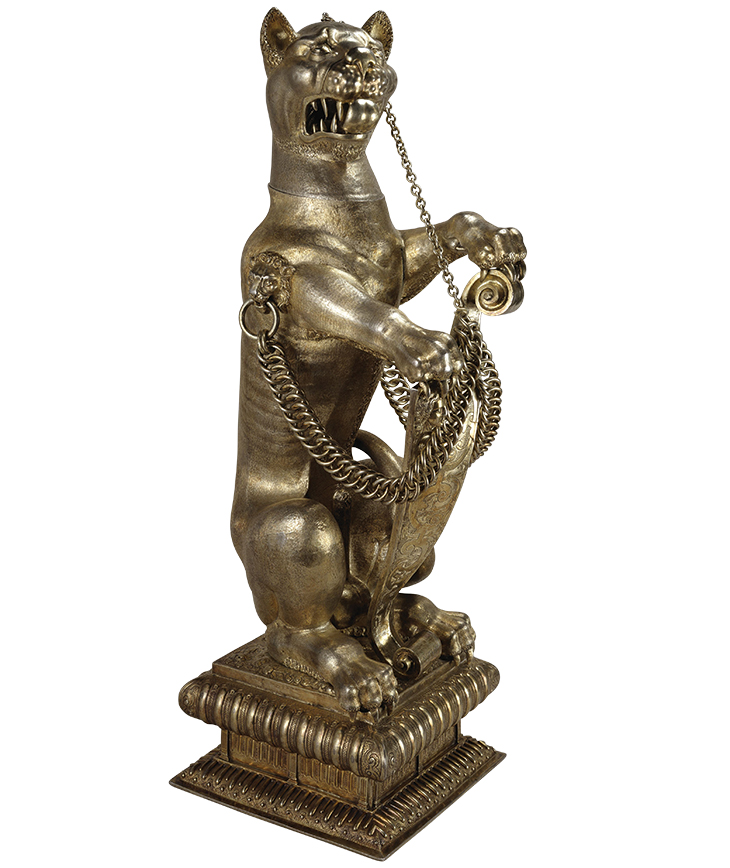
Leopard ewer (1600–01), English (London). The Moscow Kremlin Museums
The determined Westernisation of Peter the Great has come to overshadow the extent of Russia’s foreign contact prior to it: it is easy to envisage the pre-Petrine state as closed off to foreigners, as if the Kremlin’s Byzantine traditions somehow constituted a medieval isolationism that other European courts had previously shrugged off. In fact, when the English stumbled into Muscovy in the mid 16th century, the Russian court already had diplomatic links with both the Hapsburg Empire and Italy (and its architecture already had a strong Italian accent, with its merloned walls resembling north Italian fortifications) . All the same, these early ambassadorial gifts demonstrate just how intense and lucrative were the first decades of contact between the two courts, and how swiftly Richard Chancellor’s haphazard journey to Moscow opened a channel for cultural as well as commercial exchange.
Examining the art of diplomacy – and the link between its physical objects and metaphorical objectives – ‘Treasures of the Royal Courts’ also demands consideration of the modern phenomenon of ‘cultural diplomacy’. Individual inter-museum loans are unlikely to impact on international relations in themselves – if anything, the opposite is true. But in the tactful context of this exhibition, they open up a space for thinking about how objects move between countries, relaying certain ideas while attempting to conceal others. At the time of writing, the current Russian embargo on loans to US museums is in its third year, a reminder of just how politically fraught the international conveyance of art can be. But beyond this, the relative paucity of early English silver in British museums means that this selection of Kremlin treasures should come to London as both a revelation and a triumph: putting us in the position of the Tsar, the glinting objects borne before his eyes.
This article was first published in the March 2013 issue of Apollo.
‘Treasures of the Royal Courts: Tudors, Stuarts and the Russian Tsars’ was at the Victoria and Albert Museum, London from 9 March until 14 July 2013.
Unlimited access from just $16 every 3 months
Subscribe to get unlimited and exclusive access to the top art stories, interviews and exhibition reviews.


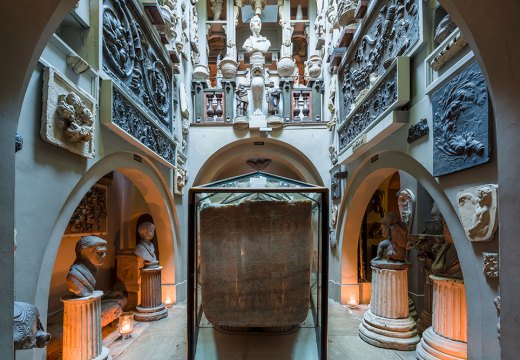

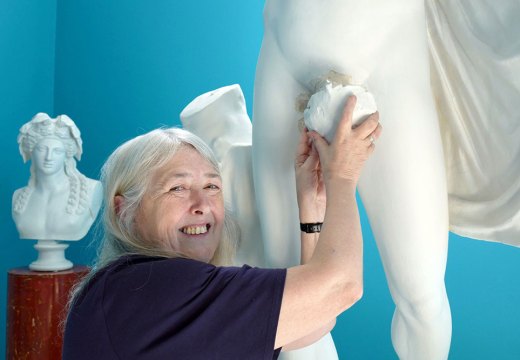









![Masterpiece [Re]discovery 2022. Photo: Ben Fisher Photography, courtesy of Masterpiece London](http://www.apollo-magazine.com/wp-content/uploads/2022/07/MPL2022_4263.jpg)
It’s time for the government of London to return to its rightful home